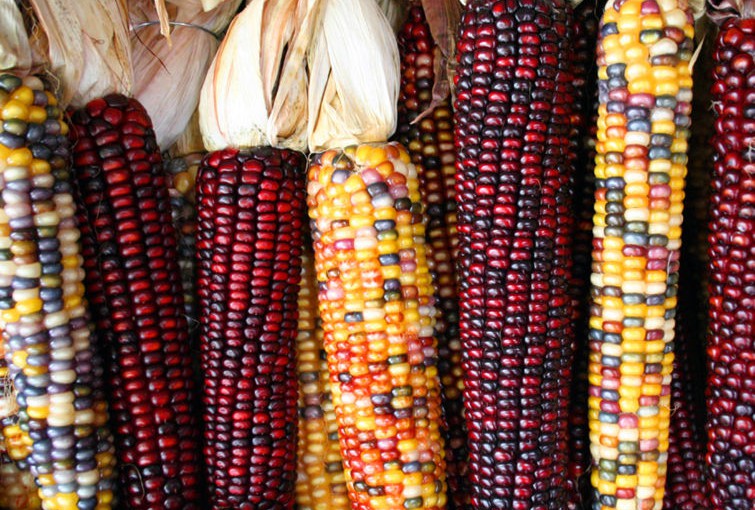
 by Debra Chase
by Debra Chase
The eldest first sister, Maize is at the center of everything, she is the supportive one with the strength to hold and carry. She sways with the wind her roots deep in Mother Earth her golden silk hair and green robe flowing gently. She is as tall as an elk and in places as thin as a reed but her many arms reach up and hold the grain in her hands that the people need. Her sister Tepary rises up and surrounds Maize with her many fingers of colorful beans adding to the nutrition of the soil and the people. Winter squash spreads her blossom necklace and wide leaves providing protection from smaller creatures hungry for Maize and Tepary. Squash prevents other plants from crowding the Sisters out of their home and she holds the water in the earth for all the Sisters to drink. The people respect the Sisters, believing the Great Spirit brought the corn, beans and squash to them and they hold great ceremony to celebrate the gifts.
The tale is ancient and many. The people of Turtle Island; Iroquois, Cherokee, Abenaki, Hopi and more loved the sisters as their own and cared for them. Often a fourth sister, Sunflower or Bee Balm was there to bring in the pollinators; bees and other beneficial insects to make sure the harvest was plentiful.
Over 5000 years ago Native Americans developed the companion planting method that has sustained the people of Turtle Island and the soil. The native people discovered that the three plants benefitted each other and as time passed they continued this practice, passing the knowledge on to each generation. These three plants are nutritionally sound for humans. Eaten together they provide essential amino acids, vitamins and minerals for good health. This type of farming also benefitted the soil. By keeping the decomposed plant material in place over winter it provides much needed microorganisms and organic material for the next growing season. Fertilizer was naturally produced and pests and weeds were kept at bay. The soil was never degraded and water use was minimal. Seed diversity was maintained as the “farmer” saved seeds for the next years planting season. This seed diversity protected the plants from disease and pests.
Today the sisters are separated. In the interests of mega production large scale agriculture requires the cutting and clearing of forests, a monoculture is created and soil is degraded with the use of commercial fertilizers and too much tilling. Often, especially with the corn plant, GMO seeds are used further degrading the plants diversity. This loss of diversity removes the plants natural protection from diseases and pests. This type of farming contributes to climate change as trees are the main user of carbon and the main producer of oxygen, soil degradation means that the soil can’t hold water so more water is needed to keep the plant alive and fertilizers, pesticides and herbicides are needed in large quantities. The end result is a disaster coming back around in the midst of a many year drought here in California that could be reminiscent of the “Dust Bowl’ of the 1930’s.
To pay homage to the Three Sisters and remember the ancient ones combine 2 cups of cooked white beans with 1 cup of kernel corn a handful of fresh chopped sage, one diced onion, two minced cloves of garlic and 1 quart of water or broth in a large soup pot, bring to a boil then reduce the heat to simmer. Add 2 cups of peeled, seeded and diced winter squash to the pot then cook for about 20 minutes until the squash is tender then season to taste with salt and pepper. Don’t toss out the squash seeds! Clean them, and then spread them out on a lightly oiled baking sheet and bake in a 350 oven until you can hear them “pop”. They will be slightly brown. Serve your Three Sisters stew with the toasted seeds on top.
Agriculture’s dark passenger is climate change. It will follow the farmer no matter where she is farming on this earth. We must be mindful of the needs of the planet for she is our life and livelihood. To save our sisters we will need to adopt more of the old ways of farming, sustaining our Mother Earth, Turtle Island. She can feed all of us if we care for her.
Aldo Leopold said, “We abuse land because we regard it as a commodity belonging to us. When we see land as a community to which we belong, we may begin to use it with love and respect.”
And he was right.
“Cause it’s the new mother nature taking over
It’s the new splendid lady come to call
It’s the new mother nature taking over
She’s gettin’ us all
She’s gettin’ us all”
No Sugar Tonight by Randy Bachman
A beautifully written, poetic piece. Thank you.
Nice piece, but can a more poetic agricultural approach feed the world?
Maybe if we all do this… https://www.youtube.com/watch?v=Y4AcmaGbldU
It can feed the people who practice it, at a level that is sustainable to the region where they are farming. Bear in mind where these practices originated. The urban farming in your video is also very effective and locally appropriate. And we need more community gardens.
Regenerative Agriculture; building the soil and companion planting all go together to produce higher yields with out the herbicides and pesticides.
There is little chance we will increase density AND have people produce their own food. It would be nice if we designated some of the unused land for community gardens. As far as I know there only the one with something like 12 to 20 plots– for a population of 65,000. It would be interesting to know what the demand is. I would jump at the chance for one near my home. I suggest a portion the high school playing fields